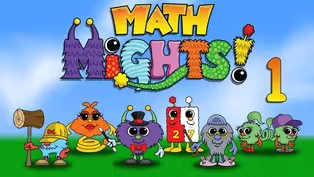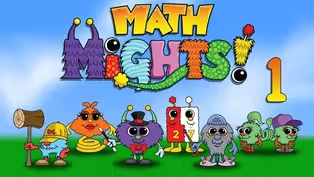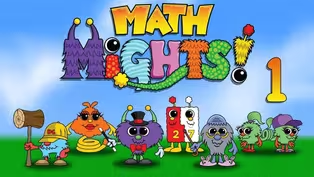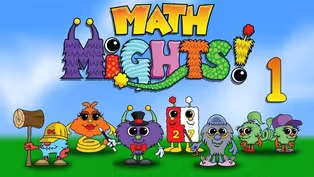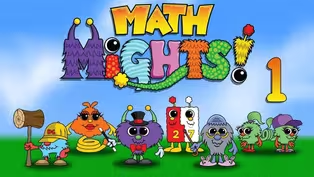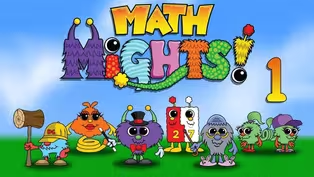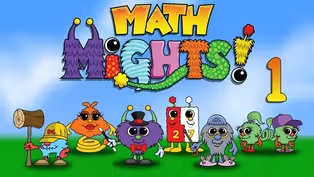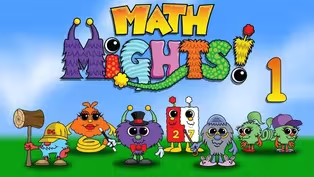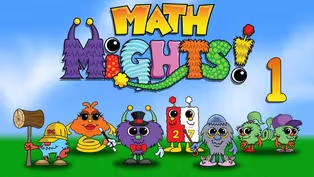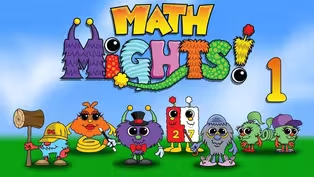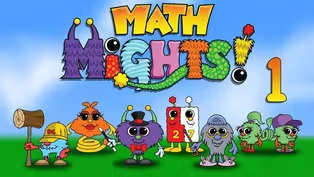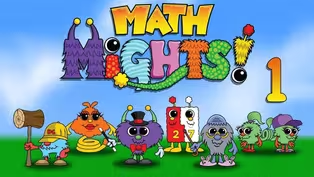Math Mights
Comparing Numbers Different Ways
Season 3 Episode 302 | 15m 44sVideo has Closed Captions
Value Pak shows you the different ways to compare 2-digit numbers.
Join Mrs. Markavich & Dotson to talk about numbers with the Counting Buddy Senior, then Value Pak shows you the different ways to compare 2-digit numbers!
Problems playing video? | Closed Captioning Feedback
Problems playing video? | Closed Captioning Feedback
Math Mights is a local public television program presented by Detroit PBS
Math Mights
Comparing Numbers Different Ways
Season 3 Episode 302 | 15m 44sVideo has Closed Captions
Join Mrs. Markavich & Dotson to talk about numbers with the Counting Buddy Senior, then Value Pak shows you the different ways to compare 2-digit numbers!
Problems playing video? | Closed Captioning Feedback
How to Watch Math Mights
Math Mights is available to stream on pbs.org and the free PBS App, available on iPhone, Apple TV, Android TV, Android smartphones, Amazon Fire TV, Amazon Fire Tablet, Roku, Samsung Smart TV, and Vizio.
Providing Support for PBS.org
Learn Moreabout PBS online sponsorshipMore from This Collection
Video has Closed Captions
Join Mrs. Markavich for a missing addend word problem with Professor Barble! (16m 5s)
Adding Tens-Tens and Ones-Ones
Video has Closed Captions
Join Mrs. Markavich for a missing addend word problem with Professor Barble! (15m 35s)
Write Equations to Match the Strategy
Video has Closed Captions
Join Mrs. Markavich for a missing addend word problem with Professor Barble. (16m 2s)
Video has Closed Captions
Join Mrs. Markavich for a subtraction word problem with Professor Barble. (15m 59s)
Video has Closed Captions
Join Mrs. Markavich for a missing addend word problem. (16m 6s)
Add 2-Digit Numbers & Write Equations
Video has Closed Captions
Join Mrs. Markavich for a word problem with her friend Professor Barble! (15m 59s)
Video has Closed Captions
Join Mrs. Markavich for a word problem with her friend Professor Barble! (15m 59s)
Video has Closed Captions
Join Mrs. Markavich for a word problem with her friend Professor Barble! (15m 59s)
Decompose/Compose #'s Different Ways
Video has Closed Captions
We show you different ways to decompose and compose 2-digit numbers! (15m 59s)
Video has Closed Captions
Join Mrs. Markavich & Dotson to talk about numbers with the Counting Buddy Senior! (16m)
Video has Closed Captions
Join Mrs. Markavich & Dotson for a Numeracy Talk with the Counting Buddy Senior (16m)
Video has Closed Captions
Join Mrs. Markavich for Numeracy Talk with Dotson working on conservation to 20. (16m)
Providing Support for PBS.org
Learn Moreabout PBS online sponsorship(cheerful music) - [Children] Math Mights!
(cheerful music) - Welcome, first grade Math Mights.
I'm Mrs. Markavich, and I'm super excited that you're here with me today.
We're going to be doing so many fun math activities.
Our plan for today is to start off with a Numeracy Talk with Dotson followed by comparing two-digit numbers in more than one way.
Let's warm up our math brains with my friend Dotson.
Here he comes.
(upbeat music) Hey, Dotson.
We're going to head over to the red carpet to see our Counting Buddy Senior.
He's waiting there for us.
Come on.
Let's go.
Our Counting Buddy Senior is a really cool tool that we can use in math.
We can use him to count numbers to 20.
Now I want you to get your camera ready to take a picture of what you see.
But this time, I want you to hold it up there because I have a secret question for you after.
Are you ready?
One, two, three.
Take that picture.
My secret question for you is this, what is two more than what you saw?
And how do you know?
My friends, Natalie and Shanice, have some ideas about what they saw.
Let's talk about what they saw.
Natalie says, "I thought 18.
Two more would be 20."
My friend Shanice says, "I saw 17, and two more would be 19."
Let's start with my friend Shanice and talk about what she got.
Shanice says, "I saw 17."
So let's build that on our Counting Buddy Senior.
It would look like this.
One, two, three, four, five, six, seven, eight, nine, 10.
I'm going to keep counting.
11, 12, 13, 14, 15, 16, 17.
Here is 17 on my Counting Buddy Senior.
And remember, my secret question was to add two more.
Let's do that now.
One, two.
And I know that 10, 11, 12, 13, 14, 15, 16, 17, 18, 19, two more would give me 19.
Great work, Shanice.
That's right.
17 and two more would be 19.
My friend Natalie says, "Thanks, Shanice.
I want to change my number to 19.
I didn't count that right.
All right, first grade Math Mights.
Let's look at our I can statement of the day.
It says," I can compare two-digit numbers decomposed and represented in different ways."
My friends Natalie and Shanice have some ideas.
They want to know who has more.
Shanice says, "I have five tens and 32 ones."
Natalie says, "I have seven tens and two ones."
So I'm wondering who has more.
We can take a look at it on our place value board.
Let's look at mine.
On this place value board, I have one, two, three, four, five tens, and then I have a whole bunch of ones.
But since we use this really cool way of putting a 10 frame on our one side, we can kind of count by tens on this side too.
We have a group of 10, 20, 30, 30, 31, 32.
Let's count that all together to get that whole number.
10 20, 30, 40, 50, 60, 70, 80, 81, 82.
And that looks like this.
Five tens and 32 ones looks like this, 82.
Now I'm gonna go over to this place value board and take a look at what I have over here.
I'm gonna the same thing on this side that I did with my other place value board.
I'm going to count 10, 20, 30, 40, 50, 60, 70.
Now count by ones, 71, 72.
The number 72 looks like this, 70, and the two hides that zero to get 72.
Now I still need to figure out who has more, Shanice or Natalie?
I'm gonna see if I can use my friend Al the Alligator or Allie the Alligator to see who has more.
When I look at the numbers, 82 and 72, I know that eight tens is greater than seven tens.
So I think I need my friend Allie the Alligator, and she is right here to help me out.
I can put Allie in the middle because Allie always chomps the greater number.
So I can say 82 is greater than 72.
Great work, first grade Math Mights, Since you're so good at this, let's take a look at another example.
I have some tens and ones in front of me, and I want to know which one is greater or less than.
My friend Shanice says, "I think the first one is greater because it has more tens."
Hmm, let's take an even closer look at it on my place value boards.
We need to take a look and see which one is greater.
Shanice says, "I think the first one is greater because it has more tens."
Let's count it and see.
10, 20, 30, 31, 32.
There is a total of 32 on this place value board.
This side only has two tens, so she thinks this number isn't going to be as big because it doesn't have as many tens.
I think we should count it.
Let's try it.
10, 20, now count on by one, 21, 22, 23, 24, 25, 26, 27, 28, 29, 30, 31, 32.
Hmm, 32.
This one has less tens and more ones, but I came up with the same number, 32.
Let me show you what that looks like.
Here is the number 32 for this side, and here is the number 32 for this side.
The number 32 looks a little bit different on both of our place value boards, but it is actually equal.
So I'm going to grab the equal sign and say that 32 is equal to 32 because both numbers are exactly the same.
You were so good at that one, Math Mights.
I am really going to make you think now, Math Mights.
We are going to take a look at two equations.
This is a little different.
We're not gonna be using the base 10 blocks this time.
I want you to look at my equations, 20 plus 13 and 13 plus 30.
The first thing we need to do is figure out how to add these numbers together before we can compare to see which one is greater or less than.
I think I need to call on my friend Value Pak.
Hey, Value Pak.
- Oh-hoo.
- Hoo, here he is to help me out.
I have it all set up in front of me.
So let's take a look at what I have.
I have the number 20 and the number 13.
And remember my friend Value Pak can click apart and work on his own, and then he can click back together.
So what I'm going to do to change this, to add 20 and 13, is I am going to pull it apart and combine my tens to give me 30 and put my ones back on because, don't forget, I love to hide that zero.
And now I know that 20 plus 13 is 33.
I'm not done yet.
I have two more numbers that I need to put together.
And my friend Value Pak is going to do the same exact thing.
These two numbers are gonna slide apart and I'm going to combine my 10 and the 30 to get the number 40.
I'm going to hide that zero, and now I have the number 43.
So now I can look at these two numbers and compare them.
I know that they both have the same amount of ones, but the tens are different.
I know that three tens is less than four tens.
So I'm going to call on my friend Al the Alligator.
He's going to come over and help me write this math stem.
It's going to say 33 is a less than 43.
Say it with me, Math Mights.
33 is a less than 43.
Wow, that was a lot of thinking.
I have one more thing that I want you to take a really close look at.
What do you notice?
When I look at this in front of me, I notice some tens and I notice some ones.
And I'm thinking, which one is greater or less, or could they be equal?
Let's take a look at the first part.
In this section, I have some tens and some ones.
Let's count them together.
Start by counting by tens.
10, 20, 30.
Keep counting.
31, 32, 33, 34, 35, 36, 37.
I'm going to write that number just so I don't forget it.
To write a 37, I do a three and a seven, and that's the number 37.
Let's hop over here and take a look at what I have here.
Wow, I have a 10, but then I have a lot of ones.
If I think back to what I learned today, I think I can group some of them together to make a 10.
Let's try it.
I have a 10.
So now I'm going to group another part together.
One, two, three, four, five, six, seven, eight, nine, 10.
I'm going to circle those like this, and I have another 10.
I'm going to do the same thing here.
One, two, three, four, five, six, seven, eight, nine, 10.
Circle that group of 10.
When I look over here, I know by looking here this is not enough to make another 10.
So now I'm going to count everything.
I'm going to start by counting by tens.
10, 20, 30, 31, 32, 33, 34, 35, 36, 37.
Ooh, I got the same number in this set that I got in this set.
Let's go down to our next section and see what number we get.
Down here I can see I have some tens.
I still have a lot of ones, so I think I'm going to use the same strategy that I did here and group them together.
Let's make a group of 10.
And I know by looking at it that I need two groups to make a group of 10.
So I am going to group this together to have a 10.
Now, when I look over here, my brain tells me this is not going to make a 10.
So I can count them.
Let's count.
10, 20, 30, 31, 32, 33, 34, 35, 36, 37.
I got the number 37 again.
I better write that right here.
My last section.
All I see are ones.
I think the smartest, most efficient thing to do is to make groups of 10.
Let's try it.
I can see I can make a group of 10 here.
I definitely think I can make another group of 10 here.
I still have a lot of ones left, and I think I can make another group of 10 here.
But when I look here, I know I don't have enough ones to make another 10, so it's time to count.
10, 20, 30, 31, 32, 33, 34, 35, 36, 37.
I had four different examples and each one of them came up with the number 37.
Wow, that's so many different ways to make the number 37.
I hope you had as much fun as I did checking out each one of these and figuring out the numbers.
Now it's time for you to play a game.
It's called Base Ten Compare, and it looks a lot like what we just did.
Thanks so much, first grade Math Mights.
I had a blast with you today.
We did so many things.
We used the Counting Buddy Senior to do a number talk and we represented numbers in so many different ways.
I had no idea I could do that.
I am so glad you were here with me today.
I want you all to kiss your brains.
(smooches) Have a great one, boys and girls.
(bright music) (cheerful music) - [Child] Sis4teachers.org.
(cheerful music) Changing the way you think about math.
(cheerful music) - [Narrator] This program is made possible with funding from the Michigan Department of Education, Governor's Education Emergency Funds, the State of Michigan, and by viewers like you.
(bright upbeat music)


- Home and How To

Hit the road in a classic car for a tour through Great Britain with two antiques experts.










Careers that Work

Support for PBS provided by:
Math Mights is a local public television program presented by Detroit PBS
